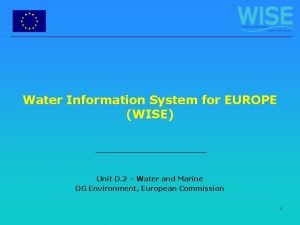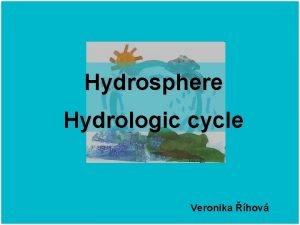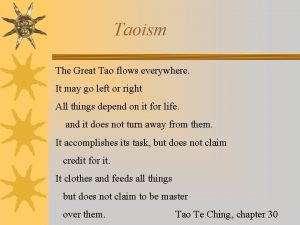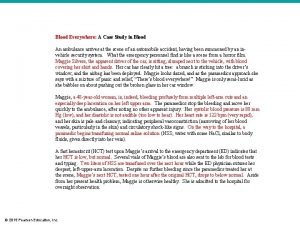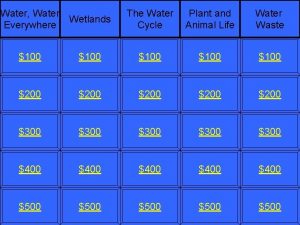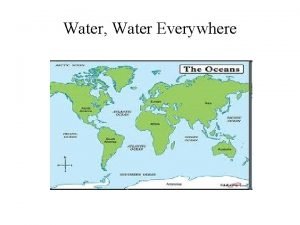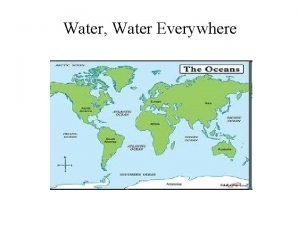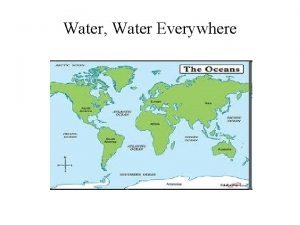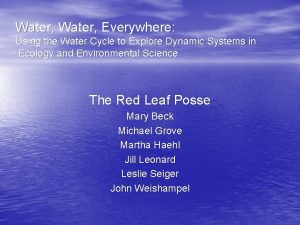The Water Cycle Water Everywhere Why is water

















- Slides: 17

The Water Cycle

Water, Everywhere! • Why is water important? • Where is water found on Earth’s surface? http: //www. brainpopjr. com/science/weather/watercycle/

Water is Changing! • Remember that water is always moving on, above, or below the Earth. And as it travels, it changes it state. It can turn from liquid, to solid, to a gas! This process of moving and changing is called the water cycle!

The Water Cycle • The water cycle is the process of how water changes form and cycles between Earth’s surface and the surrounding air (atmosphere) and back again. • There are four main parts to the water cycle: • 1. Evaporation • 2. Condensation • 3. Precipitation

Evaporation • Evaporation requires the Sun’s energy. • The Sun’s energy heats up the Earth, and the surface of the water from the rivers, lakes, and oceans. • This liquid water changes into a gas, called water vapor.

Evaporation • This liquid water changes into a gas, called water vapor. • This water vapor rises up into the atmosphere.

Condensation • Condensation happens in the atmosphere because the air temperature is cooling down. • As water vapor rises higher, the particles of water vapor cool and condense. • Water vapor (gas) collects in the atmosphere and condenses (changes back) to droplets of water (liquid. )

Condensation • Clouds form as a result of condensation (droplets of water). • Dew also forms from condensation, but the water droplets condense directly onto a surface such as grass, a car, or glass.

Precipitation • Precipitation is any water that falls from the clouds back down to Earth. • Inside a cloud, small water droplets join together and form larger ones. The droplets grow larger and heavier. When they are too heavy, they fall to Earth’s surface. • Precipitation can be in form of rain, snow, sleet, or hail.

Precipitation • When the air temperature is above freezing (0 degrees Celsius) rain forms. • When the air temperature is below freezing, snow, sleet, and hail form.

Runoff/Accumulation • If the precipitation falls on land surfaces, it attempts to return to the ocean or lakes as runoff. • Runoff is the water that flows over Earth’s surface. • The water then accumulates/collects in rivers, lakes, and oceans until the sun’s energy causes it to evaporate again.

From Sky to Earth • Water moves from the atmosphere in the sky, down to Earth and back up to the atmosphere again. It is an endless cycle of up and down! • Think about it: Does the amount of water on Earth

Let’s Review Precipitation Liquid or Solid water drops or snow/hail Accumulation Liquid or Solid water drops or snow Evaporation Gas – water vapor Condensation Gas or liquid

The Water Cycle The water cycle is the movement of water between Earth’s surface and the air.

Imagine That! • The next time that you drink a glass of water, think about how old the water might truly be! • Sure, it may have just come out of the water faucet. But before that, it was always moving as part of the water cycle! • Click the next slide to see what might have been drinking that water before you!

A Dinosaur!

It’s all possible due to the wonderful water cycle!
 Logos everywhere
Logos everywhere A paved blacktop parking lot was built
A paved blacktop parking lot was built Water water everywhere project
Water water everywhere project Unit 11 water water everywhere
Unit 11 water water everywhere Hey bye bye
Hey bye bye Water and water and water water
Water and water and water water Dont ask why why why
Dont ask why why why Water cycle brain pop
Water cycle brain pop Water cycle the hydrologic cycle
Water cycle the hydrologic cycle Importance of water cycle
Importance of water cycle I've been everywhere in canada my home
I've been everywhere in canada my home The great tao
The great tao Security that fits everywhere
Security that fits everywhere Linux everywhere
Linux everywhere It's just everywhere sexism in schools
It's just everywhere sexism in schools Love relationship and friendship goes everywhere
Love relationship and friendship goes everywhere Clot retraction
Clot retraction Every learner everywhere
Every learner everywhere



